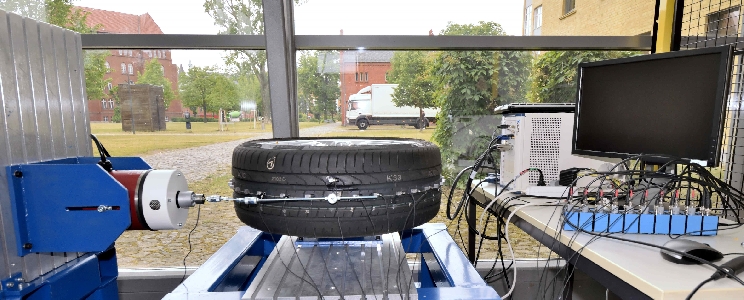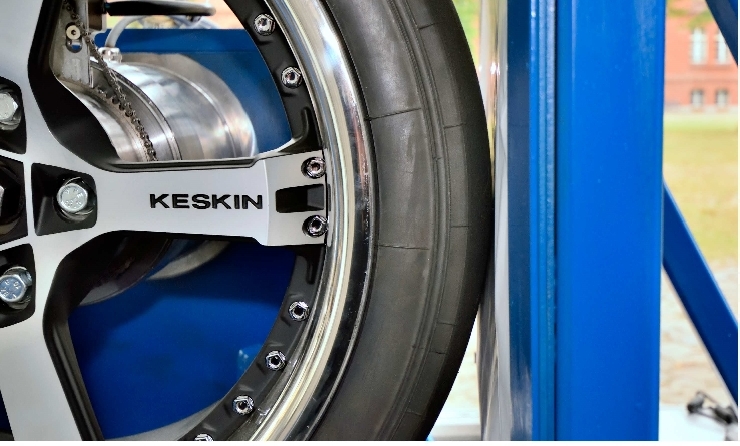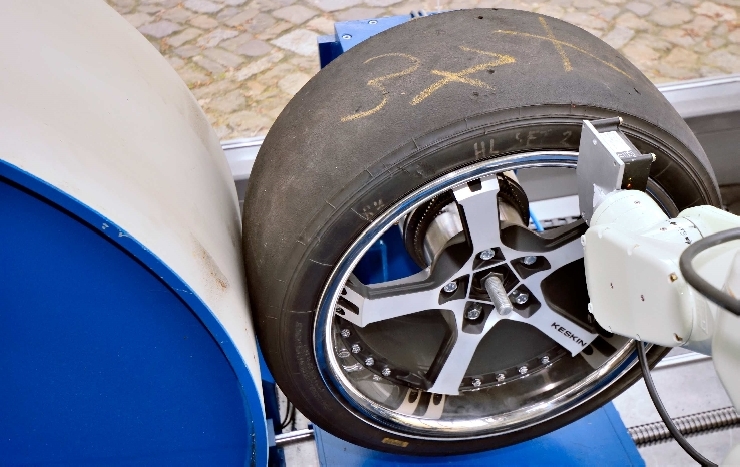The laboratory for measuring tyre characteristics (TPL) comprises test facilities for measuring properties on non-rolling and rolling wheels. The laboratory was put into operation in 2016. In addition to the tasks in research and development, it is also used to carry out student projects and graduation work, for example, in the development of tyre sensors (intelligent tyres). The main task of the laboratory is the measurement of tyre properties for the purpose of parametrizing the models formed by the finite element method.
The various test facilities are aimed at static and dynamic tyre properties and offer a matched combination of experiments for determining the required data for FE model parameter optimization. Thus, the laboratory is a key data source for building the data base on which the formation of virtual prototypes is based. Laboratory measurements do not include standard measurement such as slip force characteristics.
Test facilities for non-rolling Wheels
The experimental equipment for the non-rolling wheel includes the experimental modal analysis with electrodynamic excitation or excitation by a modal hammer, the measurement of the vertical stiffness and the measurement of the contact pressure distribution. In addition, a 3D system for the determination of the cross-sectional shape (three-axis measuring table with laser) is available, which can be used within the scope of the destructive measurement.
Modal analysis
The experimental modal analysis is usually performed with electrodynamic excitation and measurement of the accelerations at different locations on the tyre circumference. In addition, a highly refined sampling can be carried out on this test stand with the aid of the measuring robot within the range of the robot by measuring the displacement (or velocity) with a laser (laser vibrometer) measuring head, for example the local consideration of the sidewall vibrations.

These measurements can be carried out automatically by software control of the systems (shaker and robot as well as laser measurement), the device is shown in figure 1. This eliminates the expense of placing the sensors on different measuring locations or the need to invest in a multi-channel measuring system. The results of the measurements are combined with a software system for synthetic modal analysis, from which the specification of the eigensystem results - eigenfrequencies and the assignment to eigenforms.
Vertical stiffness and contact
In order to measure the vertical stiffness, the wheel can be driven against a pressure plate, whereby the camber angle can be varied. The forces on the rim can be measured using a six-component measuring device. A sensor array (128 × 128) also allows the measurement of the contact pressure distribution and, implicitly, the measurement of the contact shape. These results are also part of the target function catalogue and can therefore be directly used in optimization. Figure 2 shows the situation with the sensor array mounted.

Figure 2: Contact measurement
Test facilities for rolling Wheels
The test equipment for the moving wheel comprises the combination of stepping motor and measuring robot (tread measurements, non uniformity measurements, pump figure measurement) for the unloaded wheel as well as the measurements on the drum (vertical stiffness of the rolling wheel, obstacle crossing like cleat tests, measurements with the laser vibrometer) for the rolling wheel under vertical load and camber.

Figure 3: Drum with robot
Static deformations
In the figure 2, the drive chain of the stepper motor can be seen at the top right, with which the wheel can be rotated step by step. The measuring robot in the figure 3 carries a laser sensor for measuring distances with which the tyre surface can be scanned. In addition to the measurement of the tread design, this also allows for geometric non-uniformity measurements as well as pump deformation at different tyre pressures. The geometric non-uniformity measurements can be pasted directly into the FE model meshing procedure. The pump deformation is part of the target function catalogue.
Measurements at the drum
Measurement with the rolling wheel can be performed on the drum. These can be measurements of the rim forces when crossing obstacles on the drum. Such measurements are frequently used to parametrize tyre models by comparing the measured and computed forces. In addition, further properties can be investigated at the rolling wheel, such as the surface speed, which is of interest in the field of sound radiation. With the aid of the measuring robot and the vibrometer, the location in question can be scanned as desired on the tyre surface.
Detailed Desciption:
